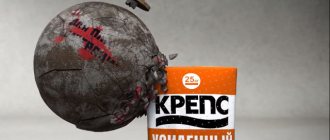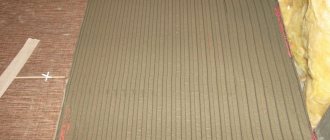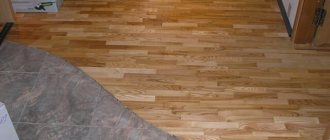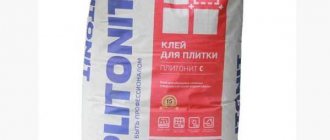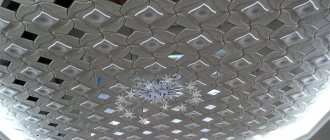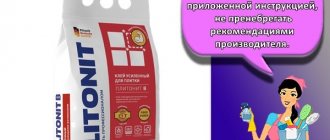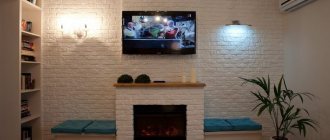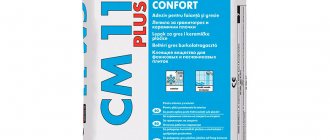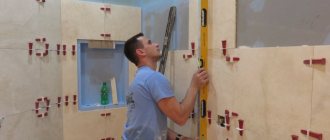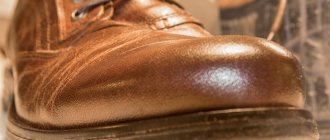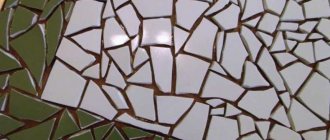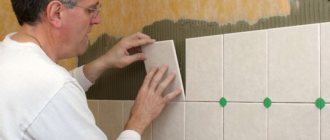Recently, more and more often, during renovations, special attention is paid to classic tiles, which are laid on the kitchen floor or mounted on the bathroom walls. The construction market is rich in products designed for fastening it, however, with all the diversity, there are special manufacturing companies that have already established themselves in this area. One of these can safely be attributed to the domestic brand Kreps. For more than 10 years, this company has been producing high-quality construction adhesive mixtures that are worthy competitors to imported analogues. Reinforced Kreps is especially popular.
Tile adhesive Kreps
Technical description
This manufacturing company (Russian-German) produces a large number of different chemicals for construction, which can be used not only by specialists, but also by ordinary people for everyday purposes.
Products for laying ceramic and porcelain tiles on various surfaces are in great demand. These adhesives can be used on surfaces such as:
- Plaster putty or plaster;
- Brick;
- Concrete, reinforced concrete;
- Warm floor;
- Tongue-and-groove slab;
- In indoor swimming pools;
- Cement and lime slabs.
The Plitonit series glue is produced in bags of 5 or 25 kilograms, as well as in three different series: A, B and C. The glue is sold in powder form, which must be diluted with water in accordance with the specified description.
The main components of such a product are cement, various fillers, modifiers, viscosity components, and additives. Powder grains no more than 0.63 mm. The product has a high level of elasticity.
Thanks to this, using this adhesive you can lay tiles on various complex bases or on vertical surfaces. The main parameters of this substance:
- The adhesive joint is 10 mm;
- Complete drying time is one day;
- Temperature during operation - +5 - +30;
- Temperature during operation – no more than +60 degrees;
- It is possible for the tiles to slip no more than 0.5 mm;
- Time to adjust the slab – no more than 20 minutes;
- Working time with the finished mixture is 4 hours;
- Frost resistance level – F35;
- Bonding to a concrete base – 0.6 – 0.5 MPa;
- Compressive strength level – M50.
The shelf life of Plitonite is 1 year; after this period, its indicators may not correspond to those indicated.
Useful tips
You cannot begin using the surface until the adhesive layer has completely dried. The same applies to grouting: it begins only after 24 hours for walls, 72 for floors, otherwise there is a risk of the tiles moving. Other tips when working with reinforced adhesive:
- The larger the tile size, the larger the teeth of the spatula should be. For elements measuring 15*15, a tooth length of 6 mm is suitable, for tiles 30*30 cm - 8 mm.
- The optimal thickness of the adhesive layer is 4 mm, but for slabs larger than 30*30 cm it is made at least 7 mm. If the floor is being laid, it is worth laying a layer up to 9 mm. The main thing is to distribute the glue evenly over the base; it is better to check this with a level.
- You can work at sub-zero temperatures only with glue to which antifreeze has been added. Other adhesives are used at positive temperatures, preferably above +5 degrees.
- Until the floor has completely dried, you should not wash the floor; contact with water and other liquids should be completely avoided.
- The base should not be subject to shrinkage or deformation. Otherwise, the tile will begin to deteriorate and move away from the surface.
If you follow all the tips, there is a high chance that the work will be completed quickly and efficiently. Reinforced adhesives can also be used under normal conditions; they always show better results in finishing work.
Types of products produced
The Plitonit company presents a large number of its products on the market. Therefore, there is a good opportunity to choose Plitonite, which is suitable specifically for this situation, based on the type of surface, type of tile, and so on. The most famous adhesives:
- Plitonite A. This option is considered universal for laying the material. It is great for working on vertical and horizontal surfaces, while the tiles adhere perfectly. It is well suited for different types of tiles and also has a high level of resistance to moisture.
- Plitonit B. This composition has certain components, thanks to which this glue is not afraid of frost. Suitable for both ceramic tiles and porcelain stoneware.
- Plitonite B+. A high level of resistance to moisture allows this glue to be used in rooms where there is a lot of moisture (swimming pool, bathroom), and a high level of resistance to frost allows this product to be used for outdoor work.
- Plitonit Express Wb. This product is the same as Plitonit B, but with a quick-hardening composition. Excellent for very urgent work, since within 2 hours after application, you can already seal the seams.
- Plitonite V Maxisloy. It is used for laying large tiles and stone blocks, as this glue has a high level of adhesion. The layer of such a product can be up to 30 mm thick.
- Plitonite B Clinker. It does not shrink, is very reliable, it is specially purchased for working with stone or clinker.
- Plitonit V Pro. This is a glue for specialists who perform complex work. For example, laying mosaics, working on a balcony, terrace, and so on.
- Plitonite V Superpol. From the name it is clear that this glue is used when laying concrete floors; with the help of this product you can level the floor and remove various defects in it.
- Plitonit Superfireplace Thermal adhesive. It is purchased to work with stoves, fireplaces or other objects that will heat up in the future. This glue can also be used as a grout for hot surfaces. Use temperature up to +150 degrees.
- Plitonit S. This product is excellent for old surfaces (for old ceramics, paint, as well as bases with some remnants of other glue). Also suitable for outdoor and pool work.
- Plitonite S Marble. Special glue for working with marble, has a high degree of resistance to moisture, dries quickly (in 8 hours), suitable for swimming pools.
Features of reinforced mixtures
When diluted with water, such mixtures form a fairly dense and elastic mass; they are most often packaged in 20-25 kg bags.
High-hold tile adhesive contains special components, such as:
- fractional sand;
- plasticizers;
- modifying substances;
- cement.
When diluted with water, such mixtures form a fairly dense and elastic mass. It is not afraid of the influence of high and low temperatures, moisture and large mechanical loads. All this allows the solution to be used both for interior cladding and for finishing building facades.
An adhesive with improved technical parameters is suitable for laying large-format heavy slabs of marble, porcelain stoneware and other mineral materials. In addition, there are mixtures that contain antifreeze. Due to this, it is possible to lay facing materials at temperatures not exceeding -10 degrees.
Advantages and disadvantages
Using Plitonit adhesives for work has a large number of advantages. The powder is easy to dilute with water, the mass is obtained almost immediately without lumps, but like thick sour cream. The advantages also include:
- Excellent bonding. The composition of the glue is such that the mixture for work is very reliable and strong, which holds the tiles perfectly. If the tiles are large, you can buy specialized adhesive of this brand specifically for such voluminous materials.
- High degree of elasticity. This is very important for a material that is subject to stress (for example, when a house shrinks). Since ceramic tiles are a fairly fragile material, this adhesive compensates for this with its elasticity; the tiles do not break or crack. This adhesive is great for laying tiles on the floor.
- High level of resistance of Plitonite to moisture. All types of this glue are quite moisture resistant, but some of them have this parameter very high. This glue is used for pools, facades, and so on.
- High level of frost resistance. There are special Plitonite adhesives that can also be used for external work. Such a seam does not crack or crumble even after several cycles of defrosting and freezing.
- High level of wear resistance of Plitonite. This product will last a long time, just like the material that is glued to it. The C series adhesives are especially strong.
Among the positive qualities of Plitonite, the following are also noted:
- Easy to knead;
- Easy to apply;
- Dries quickly;
- Short installation time;
- Low price;
- Versatility.
Among the negative aspects of Plyton, only one thing can be said - this is that it is necessary to prepare the surface very carefully and efficiently, otherwise the tile may not stick well.
In addition, the minimum packaging of glue is a 5 kg bag, so if you need to glue the tiles, there will be extra costs.
Wallpaper glue Plitonit
The raw material for the production of this type of glue is methylcellulose.
Advantages of glue
- Environmentally friendly.
- As humidity changes, the glue adapts to environmental conditions, restoring adhesion to the surface.
- It is compatible with various building materials.
- Has excellent adhesive ability.
Plitonit wallpaper glue does not form lumps when mixed with water and has antiseptic properties. It is compatible with lime and has no odor.
Types of glue
1. Plitonite Special.
Designed for gluing heavy, dense, vinyl, convex wallpaper, photo wallpaper. Suitable for common building substrates.
2. Plitonit Classic.
Designed for all types of paper wallpaper and common building substrates.
Norms for waste of funds
The average volume of substance use per 1 square meter varies depending on various reasons.
The average value is approximately 1.7-5 kg per square meter, and this is obtained depending on the following indicators:
- Size of material (the larger the tile, the thicker the adhesive layer, respectively, the greater the consumption);
- The material from which the tiles are made (ceramics absorbs less glue than tiles);
- The level of preparedness of the surface, as well as how well it was leveled (if the surface is not smooth, then more glue is needed);
- Method of applying glue (using a spatula with teeth or a continuous layer);
- The skill of the worker (those who do such work for the first time will use more glue).
Work execution algorithm
Before starting work, it is necessary that the temperature conditions specified by the manufacturer are met.
It is important that the temperature is in the range from +5 to +30 degrees. Also, it is necessary that the temperature remain at this temperature for three days after finishing work, until the glue is completely dry. You can use the floor and walls a little earlier, just a day after laying the tiles.
And if quick-drying glue was used, then this time will be even shorter. After the same period of time, you can begin to grout the seams.
General rules of application
There are a number of rules that are recommended to be followed when using the substance.
Preparation of working staff
After choosing the tile adhesive, it is worth mixing the dry composition correctly. It is recommended to prepare everything necessary for preparing the substance. Tools that may be required include the following:
- mixing container;
- water, glue;
- drill with a mixer attachment;
- putty knife.
To prepare the working composition, it is recommended to follow these rules:
- Pour water into the mixing container. The volume of liquid is determined by the amount of tile adhesive that is planned to be obtained. The ratio is indicated on the pack.
- Pour the powder into water, following the instructions. On the contrary, it is not recommended to do so.
- Using a drill, mix the mixture well. You can also use a spatula. There should be no dry fragments or lumps left in it.
- Wait a quarter of an hour and mix the substances again.
Make the solution right before use. After mixing, the finished substance should be used within 4 hours. After this period of time it will lose its fixing characteristics. Any remaining dry matter should be tightly closed and kept in a dry place.
Procedure
After preparing the adhesive for use, it is important to apply it correctly to the base and tiles. To do this, it is recommended to perform the following actions:
- Prepare the base for laying. It is recommended to level it and remove old tiles. The base is cleaned of dust and oil stains and then primed. To achieve perfect adhesion, use Kreps Primer. If the surface has a porous structure, the procedure is performed 2 times.
- After the preparatory work, it is worth applying the prepared solution. To do this, use a notched trowel.
- When laying, it is recommended to control the size of the joints between the tiles. To do this, it’s worth putting crosses correctly.
See also
What can be glued with a glue gun and how to use it, selection rules
After finishing the laying, the tiles must not be exposed to influence for 24-72 hours. It all depends on the brand of Kreps glue.
If you plan to lay large slabs, not only the base is treated with glue. In this case, it is worth covering the slabs as well.
Preparatory work
At the very beginning, you need to inspect the condition of the tiles.
If there is dirt, dust or grease on it, the level of adhesion will be low. Therefore, the tiles must be thoroughly cleaned and dried. Next, you need to check the surface, it should be strong, without any unnecessary elements that could fall off.
Otherwise, in such places the tiles may not adhere well. Also, the surface must be level, without holes, depressions and other defects.
Other tips for preparing your base:
- All defects must be covered with putty, and then walked over them with sandpaper;
- Completely remove all contaminants, degrease well with special products;
- The porous base must be primed;
- If the base is made of plasterboard, then it is better to use a primer with antiseptic qualities;
- Floors must be treated with antifungal agents, especially if they are located in areas with high humidity.
Making the substance
All components needed to make the finished solution must be at room temperature (powder and water).
The glue needs to be kept warm for about two hours. For mixing, take clean containers so that there are no other substances in them.
Mixing tools (drill attachment, mixer) can also only be used when they are clean and washed. After each work, the tools must be washed thoroughly, otherwise dried residues will reduce the quality of the new composition.
The water for mixing is also taken clean, preferably even one that is suitable for drinking, since technical water contains some unnecessary impurities. The dry powder is usually poured into water using a trowel. For 1 kg of mixture, 0.24 liters of water is usually added.
Therefore, for 5 kg of mixture you will need 6 liters of water. Algorithm for obtaining the finished solution:
- Add water to the container;
- Pour in the dry mixture;
- Mix everything with a mixer or drill.
It is important that the resulting solution has a uniform texture. So that there are no lumps. If the substance was made correctly, then when applied to the wall it will not flow. This will mean that the solution is made correctly and has the required thickness.
Next, you need to leave it for 5 minutes, then stir again. During operation, the product must be stirred periodically.
Brand information
The KREPS company began its activities in the late nineties, more than 20 years ago. Since that time, it has launched the production of dry mixtures used in construction. Today the company has the status of a federal manufacturer. There are two large factories in the Russian Federation, located in the Urals and St. Petersburg.
Among the products of this company, more than 50 types of goods can be distinguished. This list includes KREPS adhesive for tiles, main types of plaster, putties, dry mixtures with the main component of cement, special leveling solutions for damaged floor coverings and much more.
All products undergo strict testing before going on sale. Thanks to this, the risk for consumers of purchasing low-quality building materials is reduced to almost zero.
Nuances of use
This product is applied with a special tool - a spatula with teeth or a smooth spatula.
Experts apply glue using the latter. But then they make a wavy structure, so the glue glues the tile and the base even better. It is also not recommended to cover a large base with glue at once, since it quickly sets into a crust, which will have to be removed and then applied with new glue.
Here are some subtleties of working with the tool:
- After the glue has been applied, a tile is placed on it and pressed into the product with gentle turning movements, pressing on certain elements;
- To ensure that the seam between the tiles is the same, special plastic crosses are placed between the tiles;
- If it is necessary to adjust some tiles, this can be done within 20 minutes, sometimes a special level is used;
- Excess solution must be removed immediately before it dries. This is done using a metal spatula or a knife;
- The tile itself is cleaned of the product using a damp cloth.
If the material is laid on a warm floor or large tiles are laid, then a void may form between the material and the surface. In this case, the solution is applied not only to the base, but also to the tile itself.
And so that the layer of glue does not turn out to be very thick, it is applied using a spatula with teeth. If you need to level it later, this can be done with a special smooth object. It is important to wait until the solution on the floor dries completely - this is a day.
If the glue has not had time to dry completely, then the tile may move under pressure, and if the layer of glue was not thick, then the tile may even move away from the surface. Any serious impact on the floor should not be done within three days, for example, moving furniture.
If there is a heated floor, then it cannot be used for a week after laying the tiles.
And if you organize warm air in the room, this will help the solution dry faster. When working with this glue, a person must use protective equipment.
Especially when the adhesive solution is just being prepared. To prevent the powder from getting into the lungs and eyes, use special glasses and a mask - a respirator. Gloves are used for hands. If the solution does get on the skin, you should immediately rinse the area with water.
Reviews of KREPS adhesive compositions
Valery 42 years old
I have been working in finishing for over 10 years. I most often practice with tile work. Many times I have come across low-quality adhesives that are extremely inconvenient to work with. In addition to poor-quality mixing, they do not hold the tiles well and take a long time to dry. Over time, the finished surface quickly deteriorates under the influence of physical stress or moisture, as well as rising and falling temperatures. I've been using KREPS glue for about a year. I used it for the first time while working with porcelain tiles. The reinforced adhesive composition is easy to use and firmly holds decorative materials on the walls or floor. The price is lower than many famous brands.
Maxim 37 years old
This was my first time renovating my own home. It was necessary to lay tiles in the bathroom, toilet, and kitchen. For a long time I was deciding which glue was best to choose. Many of the dry mixes sold in hardware stores were confusing. After reading the opinions of experienced tilers, I chose KREPS Reinforced tile adhesive. The mixture is easy to mix and convenient to apply. It was inconvenient to lay the first slabs due to lack of practice. After some time, namely after 2 finished walls, the work went faster. The seams were sealed as indicated on the package - after 48 hours. I really liked the glue, I have no complaints about working with it.
Evgeniy 39 years old
I laid tiles at home several times, sometimes with close relatives. I came across the problem that not all adhesives are good and of high quality, i.e. meet all requests. For example, when I worked with porcelain stoneware outdoors, I used universal glue. But the finished foundation remained intact until the onset of the first serious frosts, then it was destroyed. Familiar finishers advised me to buy KREPS glue. I have used different names of this company 4 times. I can say that it is convenient to work with it, the solution is consumed slowly. If you work at home, it is enough to make a layer of no more than 5 mm to get a reliable connection.
Drawing conclusions
In the last article, Litokol adhesive for tiles was discussed in detail. This brand has, perhaps, the largest assortment among all companies, about 20 items for facing work.
KREPS Corporation develops adhesive mixtures in its laboratories using modern equipment. Technologists are constantly studying and introducing innovations in the field of chemical components that improve product quality. They study the best practices of European manufacturers, so KREPS brand compositions are environmentally friendly and easy to use.
